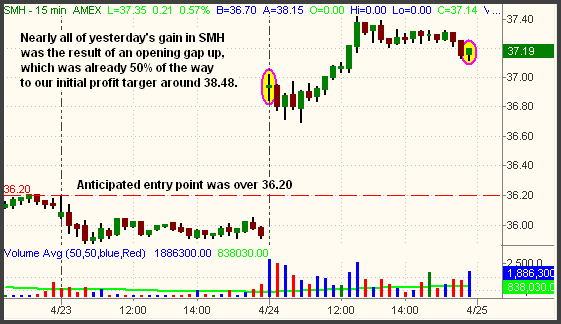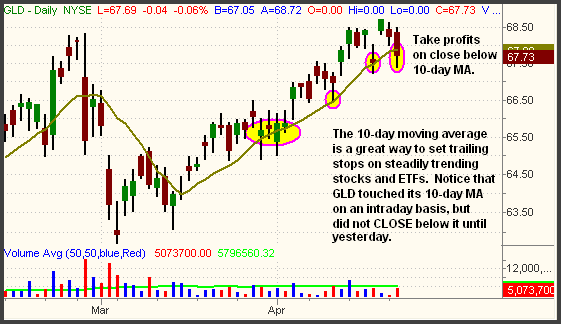|
The Wagner Daily ETF Report for April 25
Bulls in the Semiconductor sector battled with bears in many other industry sectors yesterday, causing the major indices to finish near the flat line and with mixed results. Stocks trended steadily lower throughout the first hour of trading, but found support and recovered in the early afternoon. A 3.1% surge in the Semiconductor Index ($SOX) pushed the tech-heavy Nasdaq 100 Index to a 0.5% gain, but both the broader-based Nasdaq Composite and S&P 500 indices were unchanged. Large cap stocks showed relative strength, as they have for most of the month, enabling the Dow Jones Industrial Average to advance 0.3%. The small-cap Russell 2000 and S&P Midcap 400 indices each lost 0.1%. All of the major stock market indexes finished just above the middle of their intraday ranges.
Turnover rose sharply across the board, which translated into opposing sentiments amongst the exchanges. Total volume in the NYSE was 15% higher than the previous day's level, while volume in the Nasdaq increased by 16%. Since both the S&P and Nasdaq closed flat, the higher volume was representative of "churning" that occurs when both the bulls and bears are equally active. But a closer look at the intraday volume patterns is interesting. When the S&P 500 was at its intraday low in the morning, volume in the NYSE was on pace to be 23% higher, but it receded as stocks rallied in the afternoon. Because the exchange finished with a volume increase of only 15%, this indicates the pace of yesterday's selling was greater than the subsequent buying. Slightly negative market internals confirm this as well. The Nasdaq, however, was actually bullish under the surface. At its morning low, volume was coming in only 10% above the previous day's level, but turnover increased when the index began rallying in the afternoon. Although the Nasdaq Composite failed to advance, the 0.5% gain in the Nasdaq 100 was positive because it occurred on higher volume. Overall, the market sent us quite a few mixed signals yesterday.
In yesterday's newsletter, we illustrated why we were stalking the bullish setup in the Semiconductor HOLDR (SMH). As anticipated, SMH zoomed higher, but nearly all of its 3.2% gain was the result of an opening gap up. This is illustrated on the 15-minute intraday chart below:

Although opening gaps are actually positive because they are typically supported by institutional buying, one must also consider how a gap might negatively affect the risk/reward ratio of a setup. If a stock or ETF is trading at a 52-week high and gaps higher, it is very positive because the complete lack of overhead supply enables it to continue going much higher. However, in the case of SMH, we were only looking to trade a momentum-based move into resistance of its prior high from May of 2006 ($38.48). Based on the April 23 close, the setup originally translated to an upside profit target of just under 2.5 points. But since yesterday's opening gap in SMH was nearly half of the original profit target, the potential upside reward for further gains, compared to the downside risk of getting stopped out, was not very good. The risk/reward ratio had been skewed down to about 1 to 1. As such, we made a judgment call to pass on buying the big gap on SMH. You're looking good if already long SMH, but be careful about entering near current levels unless you keep a tight stop just below yesterday's low.
Gold showed weakness yesterday, causing our long position in the StreetTRACKS Gold Trust (GLD) to hit its tight trailing stop. Although we netted an average gain of 1.3 points on the trade, we were disappointed and concerned with the lack of upside momentum GLD exhibited. Its consolidation near the prior high from February has been very choppy, so we raised our stop to just below the 10-day moving average. Since moving above its 10-day MA in March, GLD had probed below it several times on an intraday basis, but always recovered to close back above it. Yesterday was the first time it did not. Therefore, we took profits because it's logical to assume the first close below that level is likely to trigger further selling. We show only the 10-day MA on the daily chart below so that you can more easily see how well it acts as support in steady trends:

As you can see, the 10-day MA often runs just in front of support of intermediate-term uptrend lines. It is a great indicator of how steadily a stock or ETF is trending. When trailing stops on a winning position, the 10-day MA will usually get you out quickly enough to preserve profits, but not so quickly that you are shaken out on the first intraday dip.
There is definitely some arguing going on in the stock market right now. Considering that many leading stocks fell apart while the large-cap semiconductor stocks ignored them, yesterday's market action was a bit strange. The S&P 500 formed a bearish "hanging man" candlestick pattern on the daily chart, but this does not necessarily mean the market will sell-off. The S&P also had the same pattern on April 19, but gapped sharply higher the following day. The bottom line is the market's resilience has been impressive and undeniable, but the four "distribution days" in the Nasdaq over the past several weeks remain a good reason to stay on guard. Focus on trading specific industry sector ETFs, such as SMH, rather than those that mirror the indecisive broad-based indexes.
Deron Wagner is the Founder and Head Trader of both Morpheus Capital LP, a U.S. hedge fund, and Morpheus Trading Group, a trader education firm launched in 2001 that provides daily technical analysis of the leading ETFs and stocks. For a free trial to the full version of The Wagner Daily or to learn about Wagner's other services, visit MorpheusTrading.com or send an e-mail to deron@morpheustrading.com.
|